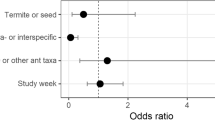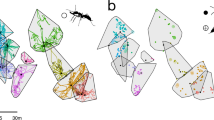Abstract
Behavioral mechanisms regulating the competitive relations between the red wood ant Formica aquilonia and the ground beetles Carabus regalis, Pterostichus melanarius, P. magus, P. oblongopunctatus, Harpalus smaragdinus, and Amara nitida were studied by artificially initiated collisions between living insects as well as with the use of imitation models. Members of different functional groups within an ant family (aphid-milkers, hunters, and guards) behaved differently towards beetles. Active ants were shown to respond selectively to different features of the possible competitors, such as coloration, the presence of “appendages” (legs, antennae), body symmetry, rate of movement, and scent. Field and laboratory experiments demonstrated the ability of beetles to avoid collisions with active ants. The scent of anthill material attracted ground beetles, which consumed dead ants. The gained individual experience may allow the beetles to use supplementary forage resources in the territories controlled by ants. The flexible tactical patterns facilitate spatial segregation of ground beetles and ants in the same territory and result in a more complete utilization of food resources.
Similar content being viewed by others
References
Cherix, D. and Bourne, J.D., “A Field Study on a Super-Colony of the Red Wood Ants Formica lugubris Zett. in Relation to Other Predatory Arthropods (Spiders, Harvestmen and Ants),” Rev. Suisse Zool. 87(4), 955–973 (1980).
Dorosheva, E.A., “Behavior of Predatory Ground Beetle Species Aimed at Avoiding Encounters with Ants within Ant Nest Territories,” in Proc. II All-Russia Soil Zoology Workshop (Moscow, 1999), pp. 187–188.
Gridina, T.I., “Influence of Formica polyctena Foerst. (Hymenoptera, Formicidae) on the Distribution of Predatory Arthropods in Forest Ecosystems,” Memor. Zool. Acad. Pol. Sci. 44, 21–36 (1990).
Gridina, T.I., “Ethological Aspects of Interrelation between Formica polyctena Foerst. (Hymenoptera, Formicidae) and Spiders and Carabids,” Memor. Zool. Acad. Pol. Sci. 48, 91–97, (1994).
Grostal, P. and Dicke, M., “Direct and Indirect Cues of Predation Risk Influence Behavior and Reproduction of Prey: a Case of Acarine Interaction,” Behav. Ecol. 10(4), 422–427 (2000).
Hawes, C., Stewart, A.J.A., and Evans, H.F., “The Impact of Woods Ants (Formica rufa) on the Distribution and Abundance of Ground Beetles (Coleoptera: Carabidae) in a Scots Pine Plantation,” Oecologia 131, 612–619 (2002).
Inozemtsev, A.A., “Dynamics of the Trophic Associations of Red Wood Ants and Their Role in Regulation of Invertebrate Pests in Oakeries of Tula Province,” Ekologiya (3), 62–75 (1974).
Jaisson, P., “L’impregnation dans l’ontogenese des comportements de soins aux cocons chez la jeune Formi rousse (Formica polyctena Foerst.),” Behaviour 52(1–2), 1–37 (1975).
Kolbe, W., “Käfer im Wirkungsbereich der roten Waldameise,” Entomol. Z. 7, 269–280 (1969).
Lovei, G.L. and Sunderland, K.D., “Ecology and Behavior of Ground Beetles (Coleoptera: Carabidae), Annu. Rev. Entomol. 41, 231–256 (1996).
MacFarland, D., The Oxford Companion to Animal Behavior (Oxford Univ. Press, New York, 1982; Mir, Moscow, 1988) [in Russian].
Malozemova, L.A., “Some Biological Traits of the Red Wood Ant in the Mountain Taiga of Northern Urals,” in Fauna of the Urals and Northern Europe (Sverdlovsk, 1980), pp. 78–87 [in Russian].
Niemelä, J., “Spatial Distribution of Carabid Beetles in the Southern Finnish Taiga: a Question of Scale,” in Ground Beetles: Their Role in Ecological and Environmental Studies, Ed. by N.E. Stork (Intersept Publ., Andover, 1990), pp. 143–155.
Pollard, J.H., A Handbook of Numerical and Statistical Techniques (Cambridge Univ. Press, Cambridge, 1977; Finansy i Statistika, Moscow, 1982) [in Russian].
Reznikova, Zh.I., “Non-Antagonistic Interactions between Ants Occupying Similar Niches,” Zool. Zh. 54(7), 1020–1031 (1975).
Reznikova, Zh.I., Interspecific Interactions in Ants (Nauka, Novosibirsk, 1983) [in Russian].
Reznikova, Zh.I., Populations and Species: a ‘War or Peace’ Concept (Logos, Moscow, 2001) [in Russian].
Reznikova, Zh.I., “A New Pattern of Interspecific Relations in Ants: the Hypothesis of Interspecific Social Control,” Zool. Zh. 82(7), 816–824 (2003) [Entomol. Rev. 83 (9), 1184–1193 (2003)].
Reznikova, Zh.I. and Dorosheva, E.A., “Effect of Red Wood Ants on the Behavior of Ground Beetles: Experiments with Individual Insects,” Doklady Ross. Akad. Nauk 375(4), 571–573 (2000).
Reznikova, Zh. and Dorosheva, E., “Impacts of Red Wood Ants Formica polyctena on the Spatial Distribution and Behavioral Patterns of Ground Beetles,” Pedobiologia 48, 15–21 (2004).
Reznikova, Zh.I. and Novgorodova, T.A., “Individual Roles and Information Exchange in Groups of Ant Workers,” Uspekhi Sovrem. Biol. 118(3), 345–356 (1998).
Robinson, M.H., “Insect Antipredator Adaptations and Behavior of Predatory Primates,” Congr. Latin Zool. 2, 811–836 (1970).
Rybalov, L.B., Rybalov, G.L., and Rossolimo, T.E., “Effect of Red Wood Ants on Litter-Dwelling Predators in Kostomuksha Nature Reserve,” Uspekhi Sovrem. Biol. 118(3), 313–322 (1998).
Sergeeva, T.K., “Serological Characterization of Trophic Associations and Resource Distribution in the Predatory Ground Beetle Assemblage,” Uspekhi Sovrem. Biol. 112(3), 32–41 (1992).
Suvorov, A.A., “Effect of Red Wood Ants on the Community Structure of Litter-Dwelling Invertebrates in Spruce Forests of Moscow Area,” in Edaphic Fauna of Moscow Province (Nauka, Moscow, 1994), pp. 74–99 [in Russian].
Tinbergen, N., The Study of Instincts (Oxford Univ. Press, Oxford, 1951).
Zakharov, A.A., “Ecology of Ants,” Itogi Nauki Tekhniki 17, 132–205 (1980).
Author information
Authors and Affiliations
Additional information
Original Russian Text © E. A. Dorosheva, Zh. I. Reznikova, 2006, published in Zoologicheskii Zhurnal, 2006, Vol. 85, No. 2, pp. 183–192.
Rights and permissions
About this article
Cite this article
Dorosheva, E.A., Reznikova, Z.I. An experimental study of behavioral mechanisms of relationships between red wood ants and ground beetles. Entmol. Rev. 86, 139–148 (2006). https://doi.org/10.1134/S0013873806020035
Received:
Issue Date:
DOI: https://doi.org/10.1134/S0013873806020035




